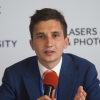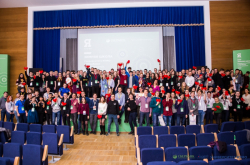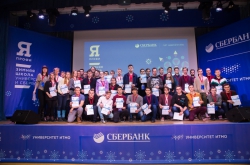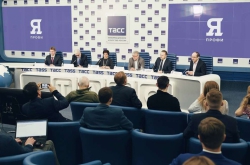How is semi-hackathon different?
Semi-hackathon has become the highlight of the “It’s Your Call!” winter school that took place last week at ITMO University as part of the All-Russian “I am a Professional” competition. The event brought together 135 of the school’s participants who came from 33 different Russian cities, its main goal being to train using a project approach for carrying out non-standard tasks as group assignments. As opposed to the classical hackathons where participants have to come up with a solution for some particular problem, this event was about working as teams in order to not just offer some solution, but use the combined expertise in different fields to present a project and work out particular ways to introducing it and bringing the end product to the market.
The project work started on the school’s first day when the participants were split into 18 teams, the prerequisite being the presence of specialists in three different fields - information technologies, photonics and information security - in each of them.

The hackathon’s topics covered six key issues: organizing a fast and safe communication channel between ITMO’s buildings and ITMO Highpark, coming up with a car-sharing concept for a system with self-driving cars, developing smart materials for photonics and communications, introducing AI in the banking sector, developing telemedicine of the future, and developing smart home projects.
In just a week’s time, the participants were to complete three stages: firstly, they had to come up with a solution to a problem within the framework of their chosen topic, secondly, they had to prepare a presentation in a pitch format, and lastly, they were to expand on their project in just seven minutes and persuade the jury that their solution would be best for the market.
The main project assessment criteria were the relevance of the chosen problem, the feasibility of the solution, the viability of the assessment of competitors, market and the proposed strategy, as well as the presentation’s quality.
“Our task was to bring together participants from different fields (as students who came to ITMO for the winter school focused on three different fields of science), so we proposed them to conduct projects within a really comprehensive range of problems. They were to find a really acute problem that had to do with one of the topics, offer the optimal solution, come up with a way to introduce it, and also assess the advances that have already been made by their competitors, i.e. study the market and the existing projects,” comments Alexander Atrashenko, the semi-hackathon’s curator and assistant to Vice-Rector for Research.

Finalists’ projects
Six teams with projects in each of the six key topics made it to the semi-hackathon’s finals. The participants of the first team offered a concept for organizing a fast and safe communication channel between ITMO’s buildings based on using the optical Magnus effect. Another team developed a project on creating multilayer glass consisting of layers of silver, silicon dioxide and polymer material for the car manufacturing industry; there was also the project of a smart fridge that used sensors and RFID tags to tell the shelf life of products, adjust for better storage of particular products, and integrate into a smart house system.
The team who got third place developed a solution as part of the “Telemedicine of the Future” topic. Its members offered to solve the problem of sick people being present at their workplace, and thus decrease the risks of a disease spreading. The authors came up with an idea of a system that will automatically analyze the employees’ condition and warn about possible problems.
Second place went to the participants who proposed a solution for carsharing of driverless cars. The authors sought to combine the advantages offered by both industries by developing a service for managing a fleet of driverless cars.

The winning team proposed a service for assessing the emotional state of bank clients. According to the project’s authors, their idea was inspired by the real life situation when clients are persistently asked to assess the quality of service. On the other hand, the banks themselves often find it impossible to quickly and adequately collect information on the quality of service.
The proposed solution was a system that allows identifying the emotions of the client and the bank employee and thus assess the efficiency of the service. The project has a technical and a software component; the first relies on three devices: a camera that is fixed on the client, the thermovision camera that allows to build a heat map of a human face, and a microphone that records the dialog between the client and the bank employee for further semantic analysis. Then the system’s software is used to process these three types of data and conduct an assessment of a client’s emotional state.
Two programmers, two physicists and two information security specialists were involved in the project; the team members represented educational institutions from all over Russia: Oryol State University, Kuban State Agrarian University, Kazan’s Innopolis, Volgograd State University and Moscow’s Higher School of Economics and Bauman State Technical University.

According to Nikita Zhuchkov, team member and second year Master’s student at Innopolis, they had very limited time to work on the project, as it was less than two days before the finals that their team decided on the topic. Nevertheless, the topic proved to be quite relevant, and the team plans to continue with their project.
“On Monday, they announced the topics and advised us to focus on using photonics for the solution. While browsing through the many different ideas that would utilize our competencies to their fullest, we’ve decided on the current topic. That was quite late - on Wednesday evening, - says Nikita Zhuchkov. First of all, we wanted to choose a problem that we all would be familiar with. Everyone has at least once received some stupid message or call from a bank. Also, we have certain expertise that allows us to tell that this would be a good enough product. We plan to continue working on it, though we haven’t decided yet on our lineup for this project.”
The semi-hackathon’s winners received gifts from ITMO.STORE and VR headsets. What is more, the members of the three best teams won the right to enter Master’s and PhD programs at ITMO University without taking exams.







